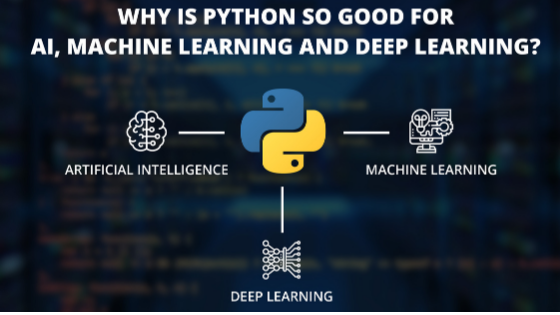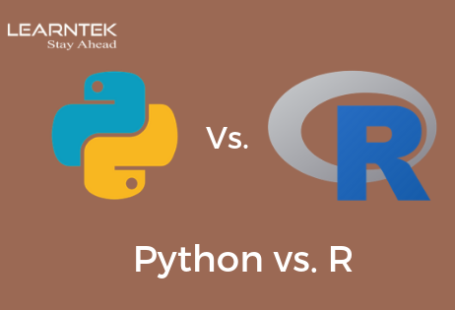Python has a rich history worth noting. From the time Python was released into popular usage in 1991, until today, it has enjoyed a prestigious position. Python is everywhere- from web development to scripting to process automation. Programmers who recommend Python emphasize it’s easy usage as one of the greatest benefits it brings to businesses.
If Python has pushed ahead in the tech world as the developers choice, it’s certainly due to a less complex syntax. Don’t take my word for it, see for yourself. Python has also slipped into the popular usage of companies like Google, Spotify, Netflix and Dropbox. Then why would this versatile programming language not make it to Machine Learning, deep learning and AI? Isn’t it? You are right, but I’ll elaborate here on why you should consider Python for the above purposes.
Key Difference between AI, ML and Deep Learning
Artificial Intelligence is the “hottest topic” in the tech industry, or perhaps in every industry. Where human brains stop functioning AI starts working. This is why businesses are switching to rely on AI for better productivity. While many businesses have already come a long way with AI and Machine Learning, others are investing in them to hit the right business goals.
Before we continue, let me tell you that these buzzwords – Machine Learning and Deep Learning are almost interchangeable. For a better understanding let me put it this way.
- Artificial Intelligence is an umbrella term and one of its technology is Machine Learning
- Further down, deep learning is one of the technologies of Machine Learning.
Basically, AI is a general category under which falls Machine Learning. And Deep Learning is a subset of Machine Learning. While most of you might be familiar with AI, you might want to know a tad bit about Machine Learning and Deep Learning
What is Machine Learning and Deep Learning?
Machine Learning is a cutting edge technology that uses algorithms to learn instructions. These algorithms then reprogramed themselves without human intervention to produce desired results with new data. The kind of results you expect from AI programmed devices.
As Machine Learning evolved into complex layers of data interpretation it led to Deep Learning. The word “deep” connotes the number of layers. It’s similar to the functioning of Machine Learning but resembles more with human learning as it works with neural network architecture.
AI, ML and Deep Learning with Python
To implement AI to achieve the best results, you will need a programming language that is flexible, versatile and consistent. Yes, that’s where Python fits perfectly. Let’s dive deeper into the discussion.
1. Simplicity and Readability
If you ask for a developer’s vote for simplicity, it’s going to be Python without a doubt. There is no other programming language that tops Python in its readability and ease. It allows developers to write more reliable codes and systems. But how does Python’s simplicity boost AI and ML? ML requires a lot of preparation so with Python coders can focus more on rectifying issues rather than getting stuck with specialised subtleties of the language.
Developers can also test algorithms without implementing them. An easy code also makes it easy to create complicated AI models.
2. Excellent choice of libraries
Machine learning and AI processing is a complicated task that requires a lot of time. So, if the codes are not well-structured and organised the process may go upside down. Developers find Python as the best solution to fix this problem.
Python has pre-composed libraries that act as its superpower. They are modules of codes used by clients to perform several activities without having to spend time working on it multiple times. With the use of libraries, you can access, deal and change information quicker- a time-saving hack indeed!
Here are some common Python libraries used for ML and AI:
- Pandas – for elevated level information structures and investigation.
- NumPy – for scientific computing and data analysis
- Keras
- TensorFlow
- SciKit
3. Independent of Platforms
Python is a platform-independent language, which means that Python programmes if designed in one machine can run on other machines without any changes. In most cases, a Python interpreter is not required to run these programmes. As a result, Python programmes are easily distributed across platforms like Windows, Linux and Mac Os.
4. Highly Flexible
It looks more like Python has a solution to everything. Programmers have the liberty to choose the style they are comfortable writing codes in. Some styles that offer breathing space for developers to tackle various kinds of issues are the imperative style, object-oriented style, functional style and procedural style. Moreover, they can also club with other programming languages to attain their goals. Flexibility offers a better environment where developers can take charge of the situation when AI systems are created.
5. Active Support Community
There is a large supporting community behind the force that is Python. This is mainly because Python is an open-source programming language. Whether you are a newbie coder or an experienced developer, a time comes when you need help in development during your journey. At this time, you get access to a major resource bundle that’s active to offer guidance. There are plenty of guides, tutorials and documentation that mainly support beginners and experts with real-time assistance. And in your machine learning journey, you do not want to give up half away due to the lack of support. Do you?
Ending Note
The future of computing is Artificial Intelligence. As more and more developers are working towards AI functionalities a less stressful and efficient work atmosphere has become a need. This doesn’t mean that other languages do not suit AI, but if it’s a comprehensive advantage that you are looking for, then Python should be your go-to option.
As can be seen from the above advantages of python over other programming languages. What’s more? Python’s basic grammar and advanced fast testing of complex calculations is also making the language open to non-developers. Hands down, Python is the problem solver of all complicated AI tasks of today and a foreseeable future.






